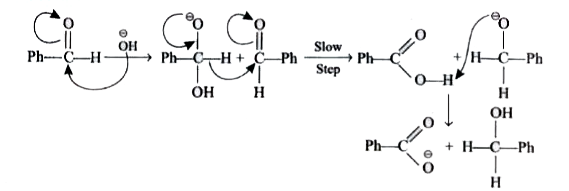In the presence of small amount of phosphorous, aliphatic carboxylic acids reacts with chlorine or bromine to yeild a compound in which α-hydrogen has been replaced by halogen. This reaction is known as
Wolf-Kishner reaction
Etard reaction
Rosenmund reaction
Hell-Volhard-Zelinsky reaction
The correct Answer is:D
Topper's Solved these Questions
- CARBONYL COMPOUNDS (ALDEHYDES & KETONES ) & CARBOXYLIC ACID Book:RESONANCEChapter:CARBONYL COMPOUNDS (ALDEHYDES & KETONES ) & CARBOXYLIC ACID Exercise:Exercise-2 Part-I
Explore 1 Video
- CARBONYL COMPOUNDS (ALDEHYDES & KETONES ) & CARBOXYLIC ACID Book:RESONANCEChapter:CARBONYL COMPOUNDS (ALDEHYDES & KETONES ) & CARBOXYLIC ACID Exercise:Part-I
Explore 97 Videos
- CARBONYL COMPOUNDS (ALDEHYDES & KETONES ) & CARBOXYLIC ACID Book:RESONANCEChapter:CARBONYL COMPOUNDS (ALDEHYDES & KETONES ) & CARBOXYLIC ACID Exercise:Exercise-1 Part-II
Explore 1 Video
- BIOMOLECULES & POLYMERBook:RESONANCEChapter:BIOMOLECULES & POLYMERExercise:ORGANIC CHEMISTRY(Biomolecules & Polymer)
Explore 33 Videos
- CHEMICAL KINETICSBook:RESONANCEChapter:CHEMICAL KINETICSExercise:PHYSICAL CHEMITRY (CHEMICAL KNIETICS & RADIOACTIVITY)
Explore 49 Videos
Similar Questions
In the presence of a small amount of phosphorous, aliphatic carboxylic acids react with chlorine or bromine to yield a compound in which α- hydrogen has been replaced by halogen. This reaction is known as :
View SolutionState True/False
A reaction in which hydrogen of an alkane is replaced by a halogen is known as Halogenation reaction
View Solution
Knowledge Check
In the presence of a small amount of phosphorous, aliphatic carboxylic acids react with chlorine or bromine to yield a compound in which α- hydrogen has been replaced by halogen. This reaction is known as :
AEtard reactionBHell-Volhard-Zelinsky reactionCWolff-Kischner reactionDRosenmund reactionWhich of the following compounds has the most acidic α -hydrogens?
A BCH3−O−O∣∣C−CH3CCH3−O−O∣∣C−CH2−O∣∣C−CH3DCH3−O∣∣C−CH2−O∣∣C−CH3
BCH3−O−O∣∣C−CH3CCH3−O−O∣∣C−CH2−O∣∣C−CH3DCH3−O∣∣C−CH2−O∣∣C−CH3Which of the following compounds has the most acidic α -hydrogens?
A BCH3−O−O∣∣C−CH3CCH3−O−O∣∣C−CH2−O∣∣C−CH3DCH3−O∣∣C−CH2−O∣∣C−CH3
BCH3−O−O∣∣C−CH3CCH3−O−O∣∣C−CH2−O∣∣C−CH3DCH3−O∣∣C−CH2−O∣∣C−CH3
Carboxylic acids having at least one α-hydrogen react with Cl2 or Br2 in the presnence of red phosphorus to give α-halo acids. The reaction is known as H.V.Z. reaction. The HVZ reaction is limited to the formation of α-chloro acid and α-bromo acid and it is sometimes difficult to carry out the reaction. Answer the following questions :
Which of the following carboxylic acids will not give HVZ reaction ?
View SolutionThe α-hydrogen atom attached to the carbonyl group is acidic in nature because the carbanion which is left gets resonance stabilished. As a result, these compounds take part in the aldol condensation reactions. The carbanion acts as a nucleophile in these reactions. The compounds in which α-hydrogen is not acidic take part in the Cannizzaro's reaction. In this reaction, one molecule of the carbonyl compound under consideration is reduced to primary alcohol while the other is oxidised simutaneously to the carboxylic acid.
An organic compound 'A' of the molecular formula C5H10Cl2 is hydrolysed to compound 'B' C5H10O which gives an oxime with hydroylamine and yellow precipitate with a mixture of iodine and sodium hydroxide. The compound 'A' should be :
View SolutionWhen chlorine is treated with carboxylic acid in the presence of red phosphorus then chloro acid will be formed, this reaction is known as :
View SolutionCarboxylic acids having at least one α-hydrogen react with Cl2 or Br2 in the presnence of red phosphorus to give α-halo acids. The reaction is known as H.V.Z. reaction. The HVZ reaction is limited to the formation of α-chloro acid and α-bromo acid and it is sometimes difficult to carry out the reaction. Answer the following questions :
Which of the following carboxylic acids will not give HVZ reaction ?
View SolutionWhen an aldehyde with no α- hydrogen react with concentrated aqueous NaOH half the aldehyde is converted to carboxylic acid salt and other half is converted to an alcohol. In other words, half the reaction is oxidized and other half is reduced. This reaction is known as Cannizzaro reaction.

Mechanism:

Which of the following will not give Cannizzaro reaction?
View Solution
